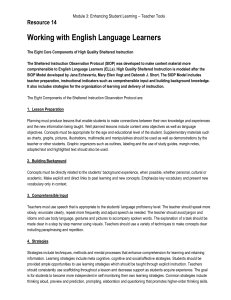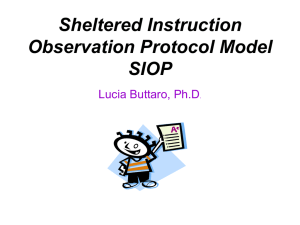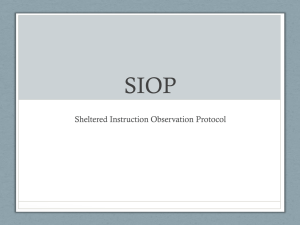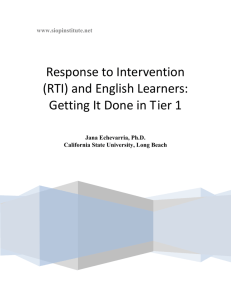SIOP: Sheltered Instructional Observation Protocol
advertisement
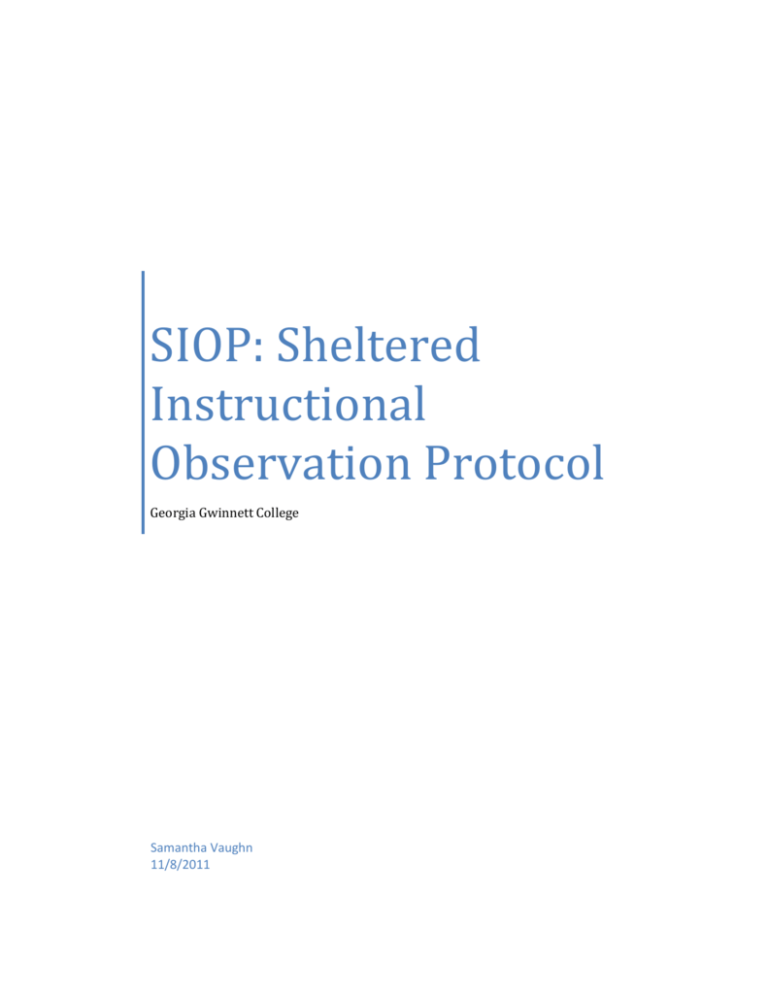
SIOP: Sheltered Instructional Observation Protocol Georgia Gwinnett College Samantha Vaughn 11/8/2011 2 Introduction The number of non-English speaking immigrants coming to the United States is increasing each year. Having this large increase in numbers also increases the responsibility for educating the students of these immigrants. “From the 1991-1992 school year through 2001-2002, the number of identified students with limited English proficiency in public schools (K-12) grew 95 percent while the total enrollment increased by only 12 percent” (Echevarria, Vogt, & Short, 2004, p. 3). This statistic is extreme. In addition “while the number of students with limited proficiency in English has grown exponentially across the United States, their level of academic achievement has lagged significantly behind that of their language-majority peers” (Echevarria et al., p. 4). English learners (ELs) once had higher dropout rates, received lower grades, and had lower scores on standardized tests than their peers. This answers that the programs schools had were ineffective and the schools had a lack of qualified ESL (English as a Second Language) teachers. Because of this shortage of teachers in the schools, the sheltered content approach was introduced. This approach integrates components from both ESL and mainstream classrooms. This instruction uses the scaffolding approach to combine prior knowledge with new content. To ensure that the sheltered instruction had an impact and affect on the students, a model was introduced, it was called the sheltered instruction observation protocol (SIOP). What do you need to understand about English Language Learners? English language learners have very diverse backgrounds, languages and education support. Some ELL students read and write above grade level in their native language, some are supported highly from their family and others might have very 3 negative school experiences that have put the lid on their motivation. It is very inconsiderate of us to think of English language learners as one-dimensional because of all the factors of their culture mentioned. “The time it takes a student to become proficient in English is based on their time in the United States, the time they have been in school, and their length of time in a particular language program” (Verdugo & Flores, 2007, p. 182). Teachers need to be aware that English language learners might be struggling with school because of their background knowledge rather than their intellectual knowledge. For example, students that live in Kansas might have a hard time writing an essay about the beach because he may have no background knowledge to build off. Another variable to consider that affects ELL’s academic success is the quality of instruction they might be receiving. “Although No Child Left Behind calls for highly qualified teachers in every core academic classroom by 2006, few states require that the teachers of core content areas have any background or training in secondlanguage acquisition, English as a second language (ESL) methods, or cross-cultural communication” (Echevarria & Short, 2005, page 2). These teachers that understand where the English Language Learner is coming from and the type of lessons they need in order to grow, encourage the students to interact in the classroom. Teachers that may not understand the students’ abilities because of such diverse capabilities may expect the students to complete worksheets, or constantly read and she may provide little to no visual aids. Teachers should be able to know who their students are, what they struggle with and their prior education experiences. “Teachers need to know how to deliver sheltered instruction –to teach content to English language learners in strategic ways that make the concepts comprehensible while promoting the students’ 4 academic English language development” (Echevarria & Short). Sheltered instruction helps students comprehend content better. For example, Genesee stated, “Slower speech, clear enunciation, use of visuals and demonstrations, targeted vocabulary development, connections to student experiences, and use of supplementary materials (Genesee, 1999). Without organized language development, many students struggle to expand their academic literacy skills that they must have to succeed in regular classrooms. What problems are there with school teaching English Language Learners? One problem found is that there are 12 states that require neither ESL nor bilingual education certification for the teachers. “Teachers’ education, certification, knowledge and experience are measures of their effectiveness; well- prepared teachers were found to affect student outcomes as much as socioeconomic factors (DarlingHammond & Ball,1998, p.2). Teachers should not only teach what they are required to teach but also what they know. The tests that teachers are required to take have received a large amount of criticisms. The problems that have been identified include: Only 29 states require teachers to take tests in the subject area they will teach (Education Week, 2000). Another issue is that “there are extreme loopholes teachers can find, like certain states require that prospective teachers only answer half of the questions on the teacher exams correctly” (Education Trust, 1999). There will always be researchers that are against every learning technique and strategy, but then there are others who find that inclusion and the SIOP are methods that help all students succeed academically. 5 According to David W. Deeds he states, “Inclusion can be a vague concept to define and therefore implement, however; what’s required for success is a codified, concrete education model such as the sheltered instruction observation protocol” (Deeds, 2008, 249). The sheltered instruction observation protocol is an aid for teachers to make subject content graspable for English learners. “The model offers a framework for selecting and organizing techniques and strategies and facilitates the integration of district-or state – level standards for ESL and for specific content areas” (Echevarria et al., p. 15-16). The SIOP model consists of 8 main fundamentals. Teachers can use these fundamentals at any time. Classroom teachers might choose to give attention to just one element depending on the stages each student is on. The 8 fundamentals include preparation, building background, comprehensible input, strategies, interaction, practice or application, lesson delivery, and review or assessment. They constantly stress the instructional methods that are critical to the success of an English learner. What are the stages in the SIOP model? Within the structure of the SIOP model, the preparation stage entails different elements such as lesson planning. Teachers must be sure they are supporting their teaching objectives to the state and district standards. Other materials and resources must also be thought of while performing this stage. The materials a teacher could use may include manipulatives, models, pictures, graphs, videos, and an assortment of reading materials. Many students prefer hands –on activities that are relevant to their own personal experiences. Making sure your lesson plans and activities provide a link to their background knowledge is crucial. Building background involves connecting new content to the students’ prior knowledge and experience also known as scaffolding. 6 English learners need repetition of activities so they can learn the language better. Certain activities for the classroom could include student interviews, conversation, observation and planned activities. When students can make the connection between new information to their prior knowledge, they are more likely to connect in the learning process. Comprehensible input is the method of speech that is used with the classroom students. Making the language simplified helps the child understand the content better. Using slow, short sentences with repetition is best for English learners. The goal should be to gradually increase the student’s vocabulary so that he/she can uphold language skills and add to their knowledge. Hand signals and organization charts can be included into the lesson plans. The next component is the strategies component. This includes scaffolding instruction. This model needs to encourage student independence. This is the “why” method. The students begin to learn why they are learning the material. Interaction gives the students the chance to use the English language. The way for the students to learn the language is for them to use it in significant ways such as; group discussion, taking turns telling stories, and group work. This gives the students a chance to express themselves at the same time as improving fluency and communication skills. Working in groups will not only increase their language skills, but also build friendships. When students are able to practice what they are learning, they are able to apply new skills. “Although all students benefit from guided practice, English learners make more rapid progress in mastering content objectives when they are provided with multiple opportunities to practice with hands-on materials and/or manipulatives” (Echevarria et al, p.118). When students can practice these new skills, it guides them to perfection. The goal is for students to mix many skills with initial 7 assistance and eventual independence. Lesson delivery helps teacher’s lesson plans and the state and local standards to fall in place together. The content should be appropriate yet challenging to the students levels. This element helps determine the success of the delivery by measuring the students understanding, participation, and ability to demonstrate the lessons. Students should constantly be dynamic in the classroom and the lessons. The last element is the review or assessment stage. This allows the teacher to provide comments and suggestions to students to ensure they are improving. Positive reinforcement is crucial for teachers to remember. Conclusion: Using these stages in the SIOP model will positively increase the ability of English learners as they utilize the language. It is the teacher’s job to ensure that he/she is teaching the material appropriately and that the students are following and learning the material at hand. Since all students are held to the same standards on state tests and benchmarks, they must all meet and understand the language. The instruction of English learners has advanced and continues to advance with the SIOP model. Teachers will have success in their classroom if they use this plan effectively. 8 Darling-Hammond, L., & Ball, D. (1998). Teaching for high standards: What policy makers need to know and be able to do. CPRE Joint Report Series with the National Commission on Teaching & America’s Future. Philadelphia, PA: CPRE. David W. Deeds, “Applying Sheltered Instruction Observation Protocol to Business/Technology Teaching in English in Asia,” vol2, pp.248-259, 2008 Fourth Inernational Conference on Networked Computing and Advanced Information Management, 2008 Echevarria, J., Short, D. (2005). The Best of Educational Leadership: Educational Leadership. Teacher Skills to Support English Language Learners, Volume 62, p8-13 Echevarria, J., Vogt, M., & Short, D. J. (2004). Making content comprehensible for English learners: The SIOP model (2nd ed.). Needham Heights, NJ: Allyn & Bacon. Education Trust. (1998, Summer). Good teaching matters: How well-qualified teachers can close the gap. Thinking K-16, 3, (2). Washington, DC: Author. Education Week. (2000). Quality counts 2000: Who should teach? The states decide. [Online] Available: http://www.edweek.org/sreports/qc00/templates/article.cfm?slug=contents.htm Genesse, F. (Ed.). (1999). Program alternatives for linguistically diverse students. (Educational Practice Report 1). Santa Cruz, CA &Washington, DC: Center for Research on Education, Diversity & Excellence. 9 Verdugo, R.R. and Flores, B. (2007) English-Language Learners: Key Issues. Education and Urban Society 39(2). 182-185.
